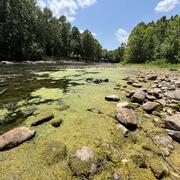Equus Recharge Project
Kansas Water Science Center
The Kansas Water Science Center provides data and research on water availability and ecosystem health in support of Federal, State, and local agencies in Kansas and across the U.S.
News
Treading Water. 6PPD and 6PPD-quinone in US Streams: Analysis, Sample Handling, and National Reconnaissance
Treading Water. 6PPD and 6PPD-quinone in US Streams: Analysis, Sample Handling, and National Reconnaissance
Central Plains Water Science Center Quarterly Newsletter - March 2025
Central Plains Water Science Center Quarterly Newsletter - March 2025
The Central Plains Water Science Center Presents: Science Seminar Series - April 2025
The Central Plains Water Science Center Presents: Science Seminar Series - April 2025
Publications
6PPD-quinone in water from the San Francisco-San Joaquin Delta, California, 2018-2024 6PPD-quinone in water from the San Francisco-San Joaquin Delta, California, 2018-2024
The Sacramento-San Joaquin Delta (Delta) is an expansive river delta supplying a large portion of California’s fresh water for agriculture and residential use, and it is also an area of critical habitat for numerous state and federally listed species of concern. In many locations, urban stormwater flows directly into the Delta. 6PPD-quinone (6PPD-Q), an ozonation byproduct of a tire...
Genome sequences of toxigenic cyanobacteria from a bloom in Lake Mattamuskeet, North Carolina (United States) Genome sequences of toxigenic cyanobacteria from a bloom in Lake Mattamuskeet, North Carolina (United States)
Lake Mattamuskeet, the largest lake in North Carolina, USA, has undergone decades-long eutrophication causing reduced water quality and promoting cyanobacterial blooms that may produce toxins. It is therefore necessary to evaluate the cyanobacterial diversity of the lake and their toxigenic potential. We present draft genomes of Microcystis, Pelatocladus, Raphidiopsis, and Umezakia...
Before the fire: Predicting burn severity and potential post-fire debris-flow hazards to Colorado River Cutthroat Trout (Oncorhynchus clarkii pleuriticus) conservation populations Before the fire: Predicting burn severity and potential post-fire debris-flow hazards to Colorado River Cutthroat Trout (Oncorhynchus clarkii pleuriticus) conservation populations
Background Colorado River Cutthroat Trout (CRCT; Oncorhynchus clarkii pleuriticus) conservation populations may be at risk from wildfire and post-fire debris flows hazards. Aim To predict burn severity and potential post-fire debris flow hazard classifications to CRCT conservation populations before wildfires occur. Methods We used remote sensing, spatial analyses, and machine learning...
Science
Effect of Water-Injection Dredging (WID) Operations on Water Quality Downstream from Tuttle Creek Reservoir
USGS continuous water-quality monitoring and discrete sampling is an integral component for understanding pre-, during, and post-WID water-quality conditions and the impacts on the surrounding ecosystems.
Leveraging UV Light for Effective Algal Toxin Removal in Drinking Water
Harmful algal blooms (HABs) pose significant risks to public health and the environment by producing dangerous toxins like microcystin-LR (MC-LR), which can exceed safety limits in drinking water. Research by the U.S. Geological Survey, The Ohio State University, and Boise State University evaluated ultraviolet (UV) light treatments for reducing microcystin levels, comparing traditional UV254 with...
Leveraging UV Light for Effective Algal Toxin Removal in Drinking Water
Harmful algal blooms (HABs) pose significant risks to public health and the environment by producing dangerous toxins like microcystin-LR (MC-LR), which can exceed safety limits in drinking water. Research by the U.S. Geological Survey, The Ohio State University, and Boise State University evaluated ultraviolet (UV) light treatments for reducing microcystin levels, comparing traditional UV254 with...






